Centuries ago, only the elite sat down.
Think about that, especially in these heady times of padded recliners. Only VIPs sat.
If you consider what ordinary people had in their homes, it does make sense. They had minimal furniture and sat on whatever was handy, whether it be a barrel or the ground.

Chairs, in fact, have a 5,000-year history. The first recorded depiction of a chairwas found in the Cycladic Islands in the Aegean Sea-a sculpture from 2,800 to 2,700 B.C.
Humans are not biologically a sitting species.
For over a millennium, chairs were not part of the working lifestyle. Over time, though, that changed to the point that in 1797, a Presbyterian minister named Job Orton advised:
“It must therefore be your resolute care to keep your body as upright as possible when you read and write; never stoop your head nor bend your breast. To prevent this, you should get a standing desk.”
Ignoring sound advice happens throughout human history, and Reverend Orton’s words fall into that category.
Working in an office became an alternative to working in the fields. As cities grew, so did the number of non-physical jobs.
In fact, beginning in the 1950s, sedentary jobs increased 83% to the point where now 75% of jobs are sedentary-based. All this sitting leads to problems.
Swiss physician, Samuel-Auguste Tissot, outlined some ailments brought on by too much sitting.
Deskbound intellectuals suffered from poor circulation and engorgement of their innards. Bad posture and lack of exercise made them susceptible to dropsy and hemorrhoids.
Doctor Tissot agrees with what new journals and articles highlight such as, “Sitting is the new smoking.”
But, Tissot wrote this in the 1700s!
Famous names in history worked while standing. Thomas Jefferson, Ernest Hemingway, Leonardo da Vinci, and Charles Dickens among many.
Now, many people, including myself, also spend a good portion of the workday standing because of my height adjustable desk.
Although they lived in different times and countries, those famous people using standing desks had another thing in common: they did not use electricity.
Crank mechanisms were the first way to adjust the height of a desk manually. Over time and improvements in technology, four primary ways evolved to adjust the height of a desk:
- Electric
- Counterbalance
- Crank
- Gas Cylinder
The first method of changing the height of a desk or work surface is by using electricity.
Today, we are going to explore the different types of manually adjustable desks and how they work.
Before Buying
Before buying a counterbalance adjustable height desk, please consider the following:
- Make sure the height of the table travels far enough, so it works for you
- Determine the weight of the items on your works surface. Knowing this weight helps to calibrate the counterbalance correctly
- Ensure you have enough room in your work area to fit the standing desk
- If the adjustable height table uses a crank to adjust the height, determine the location of the crank, so its use is not impeded by other desks, bookcases, or walls.
Counterbalance Adjustable Desks
Three Methods of Counterbalance
I have to confess. When researching this article, I had a difficult time trying to figure out how to categorize adjustable height desks using a counterbalance system.
Bill Knighton kindly explained there are three kinds of mechanisms table manufacturers use. They are:
- Single leg pneumatic counterbalance
- Two-leg pneumatic counterbalance
- Two-leg spring counterbalance
These three counterbalance methods work using similar principles. Releasing a lever moves a device to move the work surface up or down.
Imagine carrying two or three grocery bags in one arm as you reach to open the rear hatch of your SUV. You open the door and, with a single hand, raise the hatch open.
What magic is that?
Gas cylinders. Computations determine the size of a gas cylinder and the amount of weight it has to move.
In the example of the hatch of an SUV, there are two gas cylinders located on each side of the door to lift its weight.
A pneumatic counterbalance standing desk uses a gas cylinder to assist lifting the work surface.
Using the same concept, the spring tension of a counterbalance facilitates the raising the desk.
Gas or fluid flows through or around the piston from either side, equalizing the pressure on both sides.
The way the gas spring produces force is by the difference in the area inside the cylinder.
Cadlight produced the following 3D animation showing how a pneumatic cylinder works.
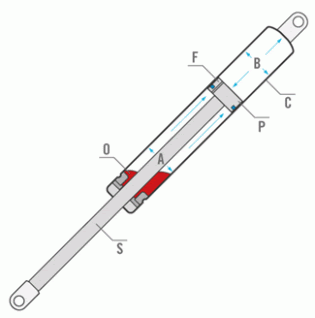
Vapsint manufacturers gas springs and provides an excellent overview of what forces are at play inside the cylinder shown in the video:
In its simplest version, the gas spring consists of a cylinder (C) and a piston rod (S), on the end of which a piston (P) is anchored, which accomplishes cycles compression and extension of the cylinder (C) through a sealed guide. The cylinder contains nitrogen gas under pressure (see arrows) and oil (O). During the compression phase, the nitrogen passes from below the piston (B) to the upper part (A) through channels (F).
During this phase the pressure inside the cylinder, due to the low volume available caused by the entering of the piston rod, is rising generating the force increment (progression). By varying the cross-section of the channels (F) the gas flow may be adjusted to slowing down or to speed up the rod sliding speed; changing the combination of cylinder/piston rod diameters, the length of cylinder, and the oil quantity the progression can be changed.
The following is a more specific breakdown of the three methods of counterbalance.
A quick note about gas cylinders and metal springs
Cylinders and springs can be designed to open and close at exact and constant speeds.
Both are simple, and there are not many moving parts.
Both methods are incredibly reliable and do not require maintenance.
There are some spring mechanism tables with weight tension adjustments available.
Single Leg Pneumatic Counterbalance
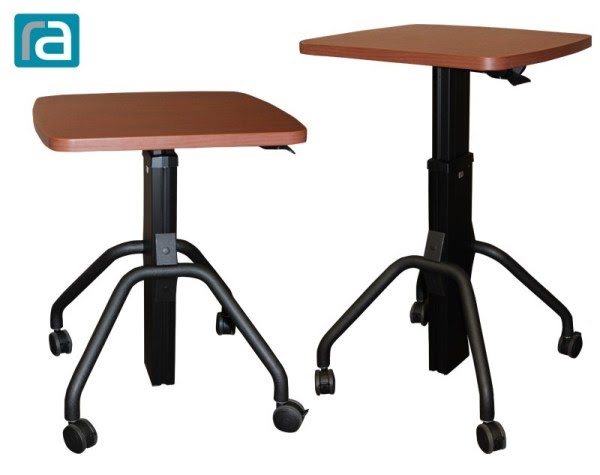
RightAngle’s Arriba is a prime example of a single leg counterbalance desk. Quickly and smoothly adjust the height of the table by squeezing a lever.
The table adjusts from 27-inches to 44-inches high and has a lifting capacity of 35 pounds.
Because of the Arriba’s versatility, many educational facilities use them.
Two-Leg Pneumatic Counterbalance
The mechanics of a two-leg pneumatic counterbalance is identical to that of a single leg counterbalance. The gas cylinder in each leg functions the same way as it does in a single leg configuration.
Because there are multiple legs to move, there has to be a mechanical system that makes both likes move simultaneously. That job falls to a cable or rod, usually hexagonal, that connects the legs.
If one leg begins to move, the hex rod rotates automatically forcing the other leg to move as well.
Two-Leg Spring Counterbalance
The pneumatic counterbalance system allows for rapid height adjustment with little noise.
One of the principal drawbacks to a counterbalance standing desk is how it handles the weight of items on top of your work surface.
This sit to stand desk has a lower weight capacity than most of the other adjustment methods.
Humanscale Float
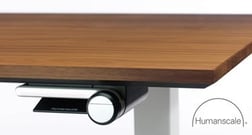
Humanscale features the Float table using a spring counterbalance system. The Float provides 20-inches of height adjustability, 27 to 47-inches from the floor.
Including the tabletop, the pneumatic counterbalance has a weight capacity of up to 130 pounds.
The Float also features an adjustment knob for the end-user to use if the amount of weight on the work surface changes.
The Float is one of the few tables on the market with this feature.
Workrite’s Cascade Counterbalance
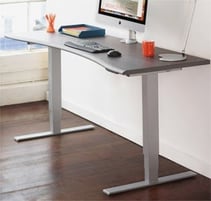
The Cascade Counterbalance system from Workrite balances payloads up to 85 pounds when properly adjusted.
Setting the height requires pulling a manual trigger and moving it to the required height.
While the Float uses an adjustment knob to adjust the tension, the Cascade requires a wrench to perform the same task.
Advantages and Disadvantages of Counterbalance Adjustable Height Desks
Advantages
- They are portable
- Very easy to operate
- Adjusting the height of the work surface is as fast as the person making those adjustments
- Quiet height adjustments
- The moving parts are simple and reliable
- Good variety of work surfaces, from large to small
- No need for electricity
Disadvantages
- Load capacities typically not exceeding 100 pounds
- Physical exertion is involved. People with physical limitations may have a more difficult time making adjustments
- Adjusting the tension settings, if modifications are possible, are very tricky
- Field service adjustments are not possible with some models
Portability
Other than not using electricity, portability is the key takeaway of manually adjustable height desks.
The ability to move the desk to more favorable locations in your office or home while not being limited to where the electrical outlet is a huge advantage.
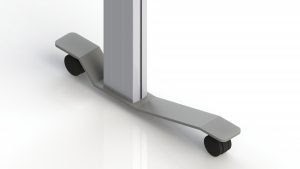
Possibly dragging the entire workstation across the room does not sound like a fun idea.
Not to mention damaging the floor, wall, or the expensive piece of office equipment you just bought.
A simple way to avoid damage and make table portability manageable is to use casters.
RightAngle’s Camille Knighton wrote an excellent article on the benefits of casters.
Purchasing a table with the option of adding casters to the table feet makes your standing desk mobile. These types of tables are used in classrooms, warehouses, training rooms, or even in your personal office space.
Buying casters for your desk may seem simple. It’s important to know that by adding them, you add a layer of complexity to the desk’s ergonomic function and stability. There are some key factors to take into consideration when purchasing a mobile sit stand table.
Those factors include how casters change the height and stability of adjustable height desks.
Regarding height changes, Camille quotes Bill:
“The table height changes when adding casters to a height adjustable table,” Knighton explained. “This decreases the level of ergonomic benefits.”
Concerning stability, Camille writes:
Casters compromise stability when added to a Sit Stand desk. The entire purpose for having casters on the table is to make the unit mobile. What if you had to lower the table to a sitting height just to enjoy the mobility feature? How often will users want to take the time to do that? Not usually, but a user shouldn’t even have to take the time to do that anyway! You need to be aware of which table styles require that extra step and what desk components you should pay particular attention to before buying.
For a complete explanation about the relationship between casters and adjustable height tables, please read the whole article here.
RightAngle’s Levante Counterbalance Standing Desks
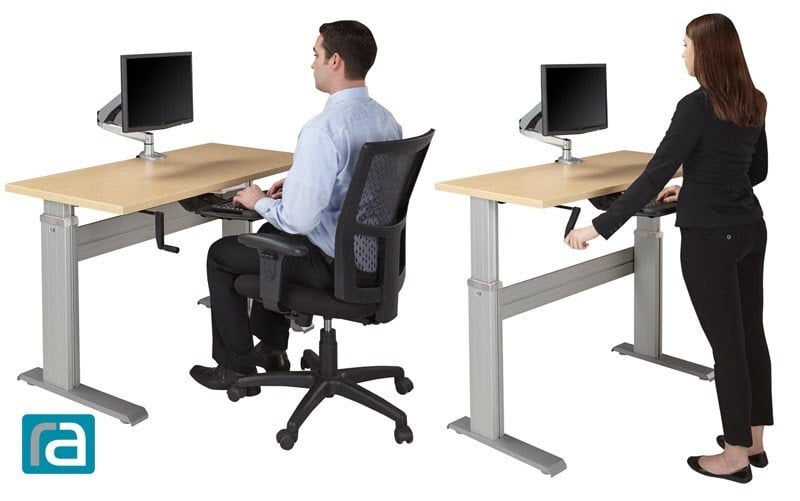
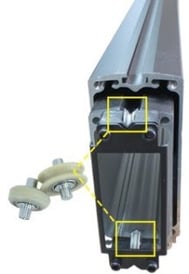
RightAngles’s Levante features the best parts of the pneumatic cylinder and the hand crank mechanisms, which results in a standing desk with rapid adjustment, smooth operation, and more substantial weight capacity.
The Levante moves 1.4 inches per rotation, so you need to make a little more than ten rotations to move 15 inches.
Refer to the table to compare the Levante to eight other manufacturers of crank adjustable height tables.
V-groove guide wheels in the Levante’s legs provide the smooth operation typically seen with paddle counterbalance tables.
| Table | RightAngle Levante | ESA Q Crank | Multitable Modtable | iMove Relevate | Omega Denali | ThermoDesk Ellure | Focal Locus | KI Genisis |
|---|---|---|---|---|---|---|---|---|
| No. Turns | 10 | 20 | 30 | 45 | 45 | 45 | 60 | 150 |
As the height of the table is adjusted, the guide wheels follow a track inside the leg—similar to the wheel and track arrangement in a sliding patio door.
Have you ever used a hand crank that lifted something with a pulley?
For example, imagine a well using a bucket to access water below. Connected by rope to the bucket through an overhead pulley is a handle.
As you crank the handle, the bucket either goes up or down. What happens when the bucket is halfway up the well, and you let go of the handle?
The bucket drops like a, well, a bucket, while the handle spins furiously.
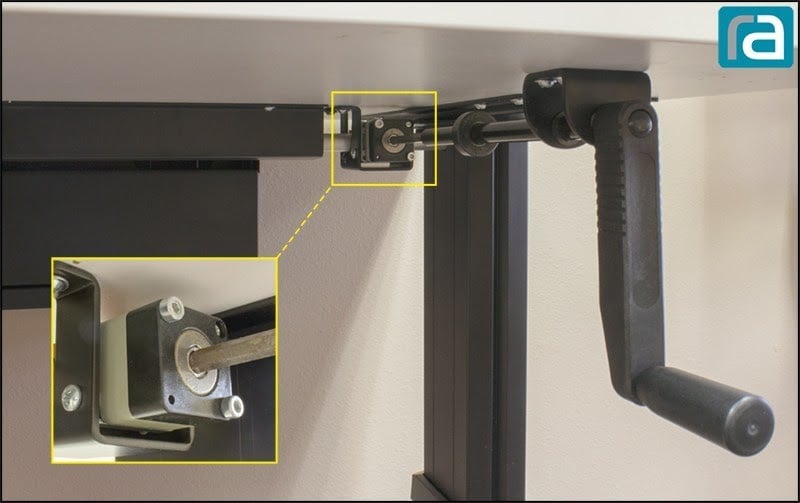
Highlighted in the above photo is the crank mechanism of the Levante.
Applying the anecdote of the bucket and the well to the Levante: when you let go of the handle, the brake mechanism prevents the table from a rapid fall.
The Levante has a 100-pound capacity and requires no adjustments when the weight changes.
Quality Ketterer Gearing
RightAngle made the decision years ago to use a gearing system from Ketterer in Germany despite the higher cost.
But, like my dad always said, buy cheap, get cheap. In this case, my dad is correct.
There is a vast difference in quality between Ketterer’s product and competitors in China: it is like riding five miles in a Ford Pinto versus a Mercedes.
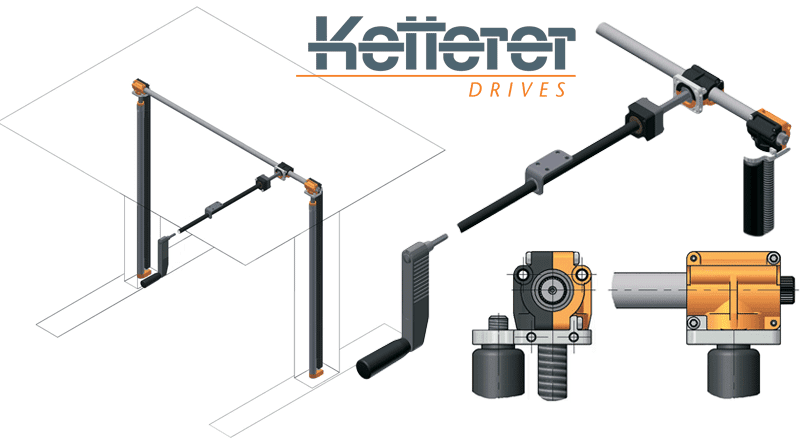
Inspecting gear quality is as simple as a pull and push. Pick up the gear and manually pull and push it out.
How smooth a gearing system moves tells you if it was built for quality or price. There are no catches when pulling a Ketterer gear; it rolls smoothly.
Gears made for the price are a different beast. When moving cheaper-built gears, they change speeds and become harder to move when you reach specific areas.
These simple results are amplified when the gears are put to use on a desk.
The slight hiccups you felt while moving the gears become lurches when running the desk.
In Sum
In a world of variety, there are only a few ways to adjust the height of a sit to stand desk. Each method has its advantages.
Do your homework before buying an adjustable height desk.
Knowing whether or not an electrical outlet is convenient, how much space is available, or even employee physical restrictions are all critical pieces of the puzzle.
Take your time and choose wisely.

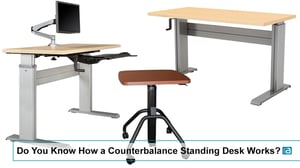
COMMENTS